By Linda Williams, forest health specialist, Woodruff, Linda.Williams@wisconsin.gov, 920-360-0665
If you’ve ever looked closely at oak leaves in late summer you know that you can find lots of interesting things on them this time of year. You’ll see anything from a variety of caterpillars and galls of all shapes and sizes to dead portions of branches caused by insects and diseases. These late season defoliators rarely cause actual health issues for the tree, and rarely require any control, but they can be very noticeable with some dramatic damage.
This year there are several insect and disease issues affecting oak trees in late summer. This article will give more information on:
- Oak webworm and striped oak webworm
- Oak blotch miner
- Oak leaf skeletonizer
- Oak slug sawfly
- Kermes scale
- Botryosphaeria canker
Oak webworm and striped oak webworm
Oak webworms have been more common in Wisconsin this year compared with past years. There are two species that make similar webs and have been found living in the same web: oak webworm (Archips fervidanus) and striped oak webworm (Pococera expandens). The striped oak webworm is known to utilize webs created by other insects like oak webworm, oak leafroller or oak leaf tier. Oak webworm caterpillars web together the leaves at the tips of branches. The webbing is strong and tight, which protects the caterpillars from predators and parasites while they feed within the web.
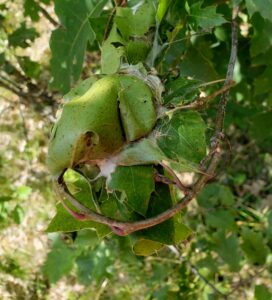 Oak webworm (Archips fervidanus) tightly webs together leaves at the tips of oak branches and feeds within the web. |
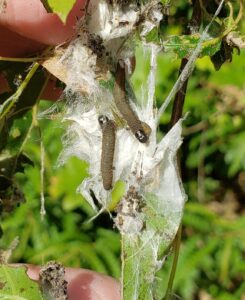 Oak webworm (Archips fervidanus) caterpillars are dark with black heads. |
 Striped oak webworm (Pococera expandens) was also found within webbing at the tips of oak branches. |
Oak leafminer
Oak leafminers (Cameraria sp.) are tiny caterpillars that feed within the leaf, mining out the material between the upper and lower leaf surfaces and leaving irregular tan blotches on the leaves. Solitary oak leafminers (C. hamadryadella) feed by themselves, while gregarious oak leafminers (C. cincinnatiella) have several larvae feeding within one blotch, affecting a much larger area of leaf tissue. Although literature indicates both species prefer white oaks, oak leafminers are also commonly found on northern red oaks in northern Wisconsin.
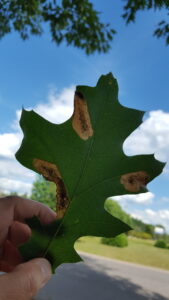
Oak leafminers feed within the leaf, leaving behind semi-transparent patches.
Oak leaf skeletonizer
Oak leaf skeletonizer (Bucculatrix ainsliella) is a tiny caterpillar that feeds on the undersides of oak leaves. Young caterpillars leave the veins and the upper leaf surfaces in place, while older caterpillars eat the upper leaf tissue, giving the remaining leaf a very lacy appearance. In late summer the upper leaves of young oaks can appear light tan where feeding has completely removed the green material between veins. Damage can look similar to that of oak slug sawfly.
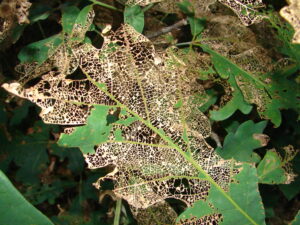
Feeding by oak leaf skeletonizer caterpillars.
Oak slug sawfly
The larvae of oak slug sawfly (Caliroa quercuscoccineae), sometimes called scarlet oak sawfly, are similar to caterpillars but look a bit like small slimy slugs. The slime helps them stick to the leaf that they’re feeding on. These tiny larvae feed on the undersides of oak leaves, scraping out the green material from between the veins of the leaves. They usually leave the upper leaf surface intact, creating a “stained glass window” look. They feed as a group and can completely defoliate leaves before they drop to the ground to pupate.
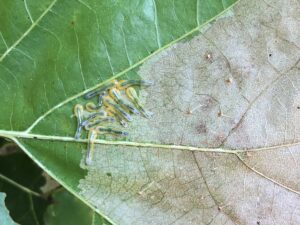 The right side of the photo shows where the leaf has already been fed upon by oak slug sawfly. Numerous slug sawfly larvae are feeding within in the green area of the leaf. |
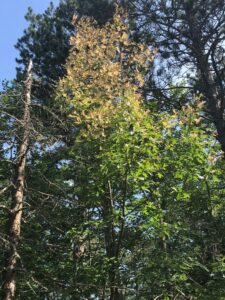 Defoliation by oak skeletonizer and oak slug sawfly causes leaves to turn a pale tan color and, upon closer examination, one can see that their tissues are actually semi-transparent. Photo by Ryan Brown. |
Kermes scale
Pin oak Kermes scale (Allokermes galliformis) is a native scale insect that attacks the shoots of young red oaks. These scales suck plant juice from the twigs and stems. The impacted tree shoots often die at the scales’ feeding site, or branches are weakened at that point and may break off later. Female Kermes scales are immobile and grow to the size of a marble, placing them in the category of “gall-like scale insects,” because they resemble twig galls in shape and size.
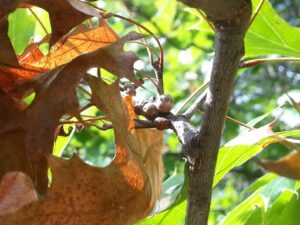
Kermes scale adults (clustered around this twig) can be the size of large peas.
Most young red oaks affected by Kermes scale only suffer minor damage. As trees grow larger, they become less susceptible to attack, and the scales are found less frequently in mature trees. Damage can look similar to that caused by Botryosphaeria canker.
Botryosphaeria canker
Botryosphaeria (Botryosphaeria quercuum) is a fungal disease that causes the tips of branches to wilt and die while the leaves remain attached. Dead twig tips often remain on the tree for weeks or months before finally breaking off. Small dark sunken cankers are sometimes visible. Damage from Botryosphaeria is more common during years with cool wet spring weather, like we had this year. This disease does cause branch dieback but it is not typically severe enough to affect the overall health of the tree. Damage can look similar to Kermes scale damage from a distance.
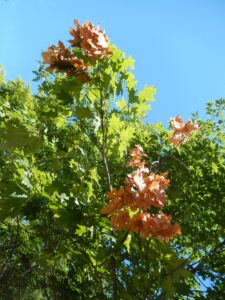 Botryosphaeria is a fungal disease that can kill branch tips, with leaves remaining attached to the dead twig. |
 Heavy infection by Botryosphaeria canker can cause branch dieback but rarely causes mortality of the tree. |
